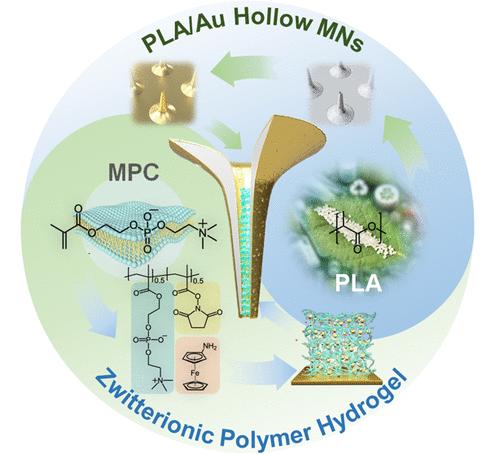Biocompatible Core–Shell Microneedle Sensor Filled with Zwitterionic Polymer Hydrogel for Rapid Continuous Transdermal Monitoring
IF 15.8
1区 材料科学
Q1 CHEMISTRY, MULTIDISCIPLINARY
引用次数: 0
Abstract
Microneedle (MN)-based electrochemical biosensors hold promising potential for noninvasive continuous monitoring of interstitial fluid biomarkers. However, challenges, such as instability and biofouling, exist. This study proposes a design employing hollow MN to encapsulate a zwitterionic polymer hydrogel sensing layer with excellent biocompatibility and antifouling properties to address these issues. MN shell isolates the internal microporous sensing layer from subcutaneous friction, and the hydrogel filling leverages the MNs’ three-dimensional structures, enabling high-dense loading of biorecognition elements. The hollow MNs are successfully fabricated from high-molecular-weight polylactic acid via drawing lithography, exhibiting sufficient strength for effective epidermis penetration. Additionally, a high-performance gold nanoconductive layer is successfully deposited inside the MN hollow channel, establishing a stable electrical connection between the polymer MN and the hydrogel sensing layer. To support the design, numerical simulations of position-based diffusive analyte solutes reveal fast-responsive electrochemical signals attributed to the high diffusion coefficient of the hydrogel and the concentrated structure of the hollow channel encapsulation. Experimental results and numerical simulations underscore the advantages of this design, showcasing rapid response, high sensitivity, long-term stability, and excellent antifouling properties. Fabricated MN sensors exhibited biosafety, feasibility, and effectiveness, with accurate and rapid in vivo glucose monitoring ability. This study emphasizes the significance of rational design, structural utilization, and micro-nanofabrication to unlock the untapped potential of MN biosensors.

生物相容性核壳微针传感器中填充了用于快速连续透皮监测的齐聚物聚合物水凝胶
基于微针(MN)的电化学生物传感器具有无创连续监测组织间液生物标志物的巨大潜力。然而,不稳定性和生物污染等挑战依然存在。为解决这些问题,本研究提出了一种采用中空 MN 封装具有良好生物相容性和防污特性的齐聚物聚合物水凝胶传感层的设计。MN 外壳将内部微孔传感层与皮下摩擦隔离,而水凝胶填充则利用了 MN 的三维结构,实现了生物识别元件的高密度装载。这种中空 MNs 是用高分子量聚乳酸通过拉伸光刻技术成功制成的,具有足够的强度,可有效穿透表皮。此外,还在 MN 空心通道内成功沉积了一层高性能纳米金导电层,在聚合物 MN 和水凝胶传感层之间建立了稳定的电连接。为了支持这一设计,对基于位置扩散的分析溶质进行了数值模拟,结果表明,由于水凝胶的高扩散系数和中空通道封装的浓缩结构,电化学信号响应迅速。实验结果和数值模拟强调了这种设计的优势,即快速响应、高灵敏度、长期稳定性和出色的防污特性。制作的 MN 传感器具有生物安全性、可行性和有效性,能够准确、快速地监测体内葡萄糖。这项研究强调了合理设计、结构利用和微纳加工对于释放 MN 生物传感器尚未开发的潜力的重要意义。
本文章由计算机程序翻译,如有差异,请以英文原文为准。
求助全文
约1分钟内获得全文
求助全文
来源期刊

ACS Nano
工程技术-材料科学:综合
CiteScore
26.00
自引率
4.10%
发文量
1627
审稿时长
1.7 months
期刊介绍:
ACS Nano, published monthly, serves as an international forum for comprehensive articles on nanoscience and nanotechnology research at the intersections of chemistry, biology, materials science, physics, and engineering. The journal fosters communication among scientists in these communities, facilitating collaboration, new research opportunities, and advancements through discoveries. ACS Nano covers synthesis, assembly, characterization, theory, and simulation of nanostructures, nanobiotechnology, nanofabrication, methods and tools for nanoscience and nanotechnology, and self- and directed-assembly. Alongside original research articles, it offers thorough reviews, perspectives on cutting-edge research, and discussions envisioning the future of nanoscience and nanotechnology.
 求助内容:
求助内容: 应助结果提醒方式:
应助结果提醒方式:


